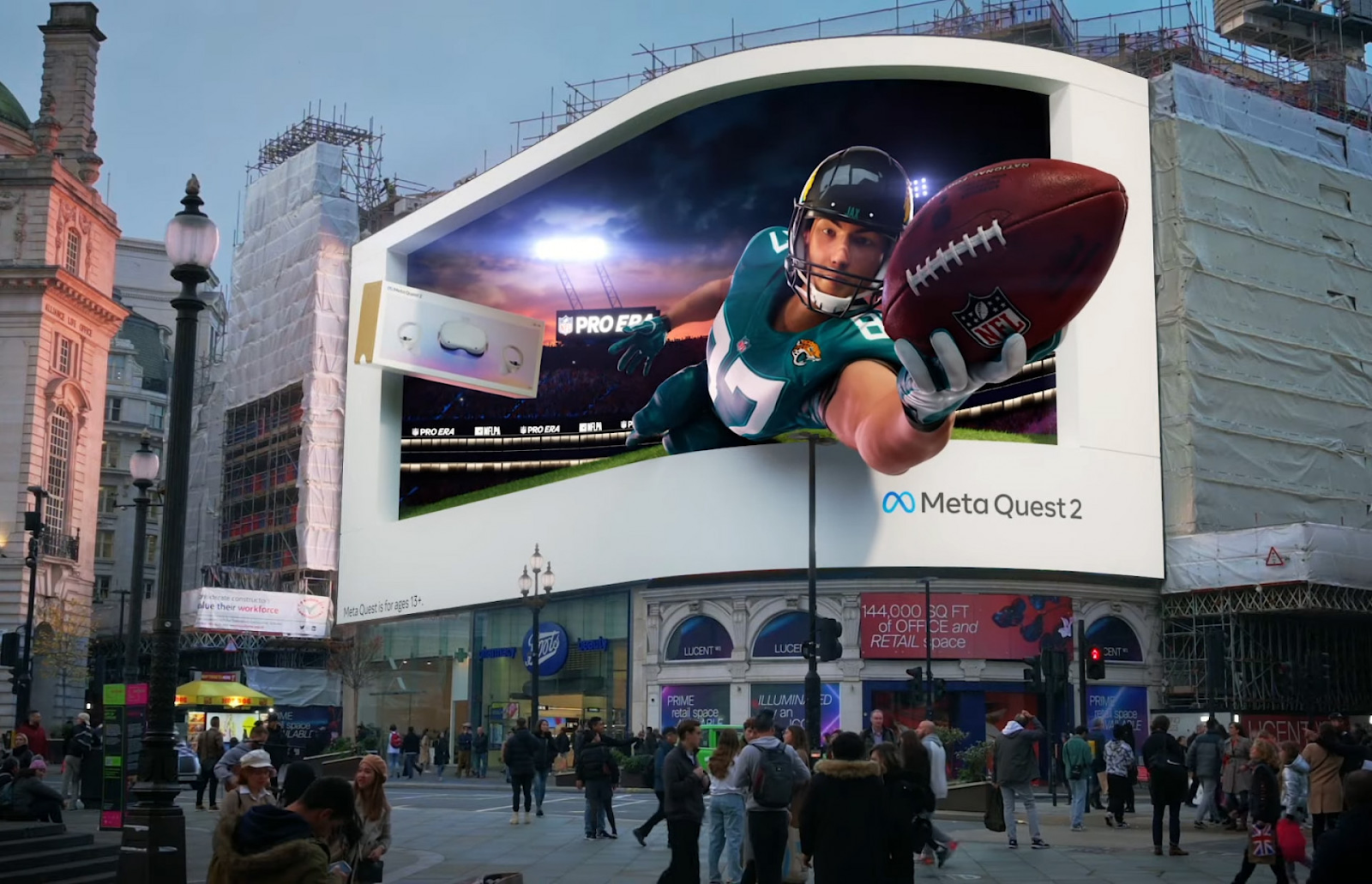Advertising isn’t what it used to be. Gone are the days when a simple billboard on the side of the road was enough to get people talking about your brand. Today, we’re dealing with a whole different beast: location-based advertising. It’s smart and strategic, and if done right, it sticks with your audience long after seeing it.
Think about it – ads at stadiums, on billboards, at bus stops – they’re not just background noise. They’re part of the environment, and that makes a world of difference when it comes to brand recall.
So, why does this matter? Well, in a world where consumers are bombarded with thousands of ads daily, being memorable isn’t just nice; it’s crucial for survival. That’s where brand recall enters the scene. It’s the litmus test for advertising effectiveness. If people remember your ad, they’re more likely to think of your brand when it’s time to purchase. Simple, right?
Let’s talk about how location-based advertising, specifically, plays into this. Whether it’s a catchy billboard on your commute or an immersive ad experience at a sports game, these aren’t just touches but memories being made. And memories mean recall. The goal is to delve into how these location-based strategies are more than just a shot in the dark; they’re precision tools in the modern advertiser’s kit, designed to make your brand not just seen but remembered.
The Power of Location: Understanding Location-Based Advertising
Alright, let’s unpack location-based advertising. In essence, it’s about placing your ad where it matters most. It’s the difference between shooting arrows in the dark and hitting the bullseye. Today’s market isn’t just about who screams the loudest; it’s about who speaks directly to the consumer right where they are.
Location-based advertising takes many forms. We’re talking billboards that catch your eye while you’re stuck in traffic, digital screens at bus stops that entertain you as you wait, or even those massive LED displays at stadiums that you can’t help but look at during game breaks. Each of these platforms offers a unique advantage: context. For example, a billboard outside a shopping center might showcase a timely sale, tapping into the immediate buying mood of consumers passing by.
Why does this matter? Let’s bring some numbers into the mix. A study from Nielsen showed that outdoor advertising could increase brand recall by up to 62%. That’s not a number to scoff at. And when you consider that a significant portion of consumer decisions are made spontaneously, being at the right place at the right time with the right message can turn a passerby into a customer.
But it’s not just about throwing up a billboard anywhere. These ads leverage the environment and context to supercharge brand recall. Take, for example, a sports brand advertising at a stadium. Fans are already in a heightened state of excitement, associating the adrenaline rush with the brand on display. Or consider a health-focused billboard at a transit station in January, tapping into New Year’s resolutions. This strategic alignment of location, mood, and message turns a simple ad into a memorable experience.

In highly competitive consumer landscapes, this approach isn’t just effective; it’s necessary. And in rapidly growing economies like India, Indonesia, or Vietnam, where urban spaces and consumer attention are at a premium, location-based advertising stands out as a smart investment for brands aiming to leave a lasting impression.
Location-based advertising isn’t just about being seen; it’s about being remembered and doing it in a way that feels almost like serendipity to the consumer. And in today’s fast-paced world, that’s the kind of advertising that cuts through the noise.
The Psychology Behind Brand Recall
Let’s dive into the brainy stuff – the psychology that powers brand recall. It’s not just about seeing an ad; it’s about how that ad makes you feel and the context in which you see it. This is where location-based advertising really flexes its muscles.
First off, our brains are wired to associate memories with specific places. Have you ever walked into a room and remembered something you forgot earlier? That’s because environmental cues play a huge role in recalling information. Apply this to advertising, and you’ve got a potent mix. A billboard on your daily commute becomes a repeated cue, reinforcing the brand in your memory every day. It’s like setting a reminder for your brain without the annoying notification sound.
Now, add a dash of emotion to the mix. Emotions turbocharge memories. Think about it: you’re more likely to remember your first concert vividly than what you had for lunch two Thursdays ago. That’s because heightened emotional states make experiences more memorable. Location-based advertising leverages this by choosing settings that naturally evoke emotions. A thrilling sports game, the anticipation of travel at a bus station, or the excitement of a holiday shopping spree can all enhance the emotional impact of an ad, making the brand more memorable.

Consider the unforgettable atmosphere of a packed stadium during a critical match. Brands advertising in such environments aren’t just showcasing their logos; they’re becoming part of a momentous experience. The excitement, joy, or even the game’s tension gets linked with the brand, creating a powerful emotional memory.
And it’s not just about the big moments. Even the everyday context has its magic. A study highlighted that ads placed in locations congruent with their message (think of a sunscreen ad at a sunny beach bus stop) can increase brand recall significantly. It’s about creating a natural link between the setting, the emotion felt, and the brand, making the advertisement part of the consumer’s personal narrative.
So, when we talk about the psychology behind brand recall, it’s not just academic. It’s understanding that the right place and emotional tone can make your brand not just seen but remembered. And in a world where attention is the ultimate currency, being memorable is priceless.
Key Strategies for Successful Location-Based Advertising
Let’s explore the core elements that make location-based advertising campaigns successful. Understanding these strategies can help brand leaders craft campaigns that capture attention and enhance brand recall effectively.
| Market/Location Type | Strategy | Expected Outcome | Why It Works |
| Stadiums | Utilize emotional moments during games to display ads. | Increased brand recall and emotional connection. | High emotional engagement enhances memory retention. |
| Billboards | Implement dynamic digital billboards that change based on the time of day or weather. | Higher relevance and noticeability of ads. | Tailored messages grab attention and stay memorable due to their relevance. |
| Transit Stations | Leverage QR codes in ads for exclusive offers. | Enhanced interaction and brand recall. | Direct engagement through technology increases the likelihood of recall. |
| Bus Stops | Integrate environmental elements (e.g., solar-powered lights) into the ad design. | Positive brand association and recall. | Innovative use of the environment aligns the brand with sustainability, enhancing recall. |
| Trains and Buses | Use interior ads to provide useful information or entertainment. | Improved brand perception and recall. | Providing value leads to positive associations and stronger recall. |
| Digital Screens | Create interactive ads that invite passersby to engage. | Increased brand engagement and recall. | Interactive experiences are memorable and foster a direct connection with the brand. |
This table is a starting point for discussing various strategies and their effectiveness in enhancing brand recall through location-based advertising. Remember, the key to a successful location-based advertising campaign lies in understanding your target audience’s specific needs and behaviors and the unique characteristics of each location.
Measuring the Impact: Market Research in Action
Once you’ve got your location-based advertising out in the world, the next step is critical: measuring its impact. How do we know if these ads are hitting the mark? That’s where market research comes into play, serving as the backbone for understanding the effectiveness of our advertising strategies.
Market Research Techniques:
- Surveys: The go-to method for gauging ad recall. By asking consumers directly, we can get insights into which ads they remember and why. It’s straightforward and can be tailored to specific campaigns, making surveys a versatile tool in our arsenal.
- Focus Groups: Here’s where we dive deeper. Focus groups allow for nuanced discussions about an ad’s impact, providing qualitative data on consumer perceptions and emotional reactions. This method highlights the why behind the recall, offering rich insights that surveys alone might not uncover.
- Observational Studies: Sometimes, watching behavior in the wild can reveal more than direct questioning. Observational studies track how consumers interact with ads in real-life settings, offering unfiltered insights into their engagement and recall behaviors.
- Exit Polls: Utilized particularly in high-traffic locations like malls, cinemas, or events, exit polls involve asking individuals about their recall of ads as they leave a specific area. This method can provide immediate feedback on the impact of ads placed in strategic locations, offering insights into the spontaneity of brand recall post-exposure.
- Digital Analytics: By integrating QR codes and NFC (Near Field Communication) tags in physical ads, brands can track engagement through digital analytics. When consumers interact with these elements using smartphones, brands can measure the direct response rate, time spent on linked digital content, and subsequent online behavior, offering a quantitative measure of ad effectiveness.
- Social Media Monitoring: By tracking mentions, hashtags, and engagement on social media platforms, brands can gauge consumer reactions and recall of location-based advertising campaigns. This method allows for real-time monitoring of the public’s sentiment and the viral impact of campaigns.
- Eye-Tracking Studies: In controlled settings or with mobile eye-tracking technology, researchers can study exactly what catches consumers’ attention in an ad and for how long. This method is particularly useful in understanding the visual elements of location-based advertising that contribute to brand recall.
- Heat Maps: Using technology to track movement and density, heat maps can show where potential customers spend the most time in relation to an ad placement. This method helps in understanding not just recall but also the physical engagement and attractiveness of an ad’s location.
- A/B Testing: By varying the message, design, or location of ads within the same market, brands can conduct A/B tests to determine which variations perform better in terms of recall and engagement. This method relies on direct comparison and can be particularly effective in fine-tuning campaign strategies.
Advanced Analytics and Technology:
The role of technology in market research cannot be overstated. With advancements in analytics, we can now delve into data like never before, using tools such as eye-tracking to see exactly what captures consumers’ attention or sentiment analysis to gauge emotional reactions to ads on social media.
Moreover, big data analytics allows us to sift through vast amounts of information to identify patterns and trends. For example, geolocation data can help understand how foot traffic near billboards correlates with sales spikes, directly linking ad placement and consumer action.

One example is Nielsen’s “Out-of-Home Advertising Study 2019,” which highlighted how out-of-home advertising reaches a vast audience and significantly boosts online engagement, with participants showing a marked increase in online activities related to the ads they encountered. This study showcases the tangible impact of location-based advertising on consumer behavior, serving as a solid benchmark for marketers looking to measure their campaigns’ effectiveness.
Market research in location-based advertising combines traditional methods with cutting-edge technology to get a holistic view of how our ads resonate with consumers. It’s this blend of the old and new that enables brand leaders to refine their strategies, ensuring that their messages not only reach the right eyes but also stick in the minds of their audience.
Innovations in Location-Based Advertising
Location-based advertising is not just evolving; it’s transforming, thanks to a wave of technological innovations. These advancements are not merely adding a new layer to advertising but reinventing how we connect with consumers, making experiences more immersive, interactive, and memorable. Let’s look at a few game-changers: Augmented Reality (AR), Virtual Reality (VR), and the Internet of Things (IoT).
Augmented Reality (AR): Imagine walking past a bus stop and seeing an ad for a new sneaker. With AR, you don’t just see the sneaker; you can watch it come to life, explore its features, and even see how it looks on your feet, all through your smartphone screen. AR brings products out of the billboard and into consumers’ hands (and onto the feet), creating a memorable, interactive experience that significantly boosts brand recall. Nike, for instance, has been pioneering in this space, using AR for product launches and to enhance customer experiences in stores and via mobile apps.

Virtual Reality (VR): While AR brings digital elements into our natural world, VR takes us into a completely new one. Imagine putting on a VR headset at a mall kiosk and being transported to a concert where the brand is part of the experience. VR can create deeply immersive experiences that engage consumers emotionally, making the brand part of a memorable adventure. While more niche due to the need for specific equipment, VR’s potential to create impactful brand experiences is immense.
Internet of Things (IoT): The IoT makes it possible for everyday objects to communicate with each other. IoT is making location-based advertising smarter and more responsive, from smart billboards that change content based on real-time data (like the weather or traffic) to interactive displays that react as consumers approach. This increases engagement and ensures the advertising content is as relevant and timely as possible, increasing the likelihood of brand recall.
These innovations are not just futuristic concepts; they are being integrated into advertising strategies today, offering new ways to capture consumer attention and leave a lasting impression. By leveraging AR, VR, and IoT, brands can create advertising experiences that are seen, felt, remembered, and talked about long after the consumer has moved on. This is the power of innovation in location-based advertising—turning every encounter with an ad into an opportunity for engagement and connection.
Strategic Insights for Brand Leaders
Location-based advertising offers a goldmine of opportunities for brand leaders eager to make their mark and connect deeply with their audience. However, the effectiveness of these strategies hinges on making informed, strategic decisions every step of the way. Here are actionable insights to help brand leaders leverage location-based advertising effectively.
Choosing the Right Locations:
- Target Audience Insights: Begin with a deep understanding of your target audience. Where do they spend their time? What are their habits and preferences? Data analytics can offer profound insights into consumer behavior, helping you choose locations that align with your audience’s daily routines.
- Visibility and Traffic: High-traffic areas are generally promising, but consider the context of visibility. An ad in a busy subway station might see more eyeballs, but a billboard on a less congested road where drivers are more likely to pay attention could be more impactful.
- Competitor Presence: Analyzing where competitors are advertising can provide valuable insights. There’s a strategic decision to be made in either placing your ads near competitors to tap into an established audience or choosing untapped locations to stand out.
Crafting Memorable Messages:
- Simplicity and Clarity: Your message must be clear and straightforward in the fast-paced environment of outdoor and location-based settings. A compelling visual with a concise message often resonates more than a crowded, complex ad.
- Emotional Connection: Tap into the emotional aspect of advertising. Use storytelling elements that resonate with the local culture or leverage everyday experiences and emotions associated with specific locations.
- Contextual Relevance: Tailor your messages to the context of the location. Ads that reflect or play off their environment can create more engaging and memorable experiences—for instance, an ad for rain boots at a bus stop on a notoriously rainy street.
Integrating with Broader Marketing Campaigns:
- Cross-Channel Synergy: Ensure your location-based advertising complements your broader marketing efforts. Use QR codes or social media hashtags to bridge the gap between physical ads and digital platforms, creating a seamless consumer journey.
- Measurement and Optimization: Incorporate mechanisms to track the effectiveness of location-based ads in driving brand recall and other key performance indicators (KPIs). Use this data to refine and optimize your location-based and broader marketing strategies over time.
- Leveraging Technology: Stay abreast of technological advancements in AR, VR, and IoT to enhance the impact of your location-based advertising. These tools can offer novel ways to engage consumers and can be integrated into broader marketing campaigns for added effect.
For brand leaders, the path to success with location-based advertising lies in being strategic, creative, and responsive to data and insights. By carefully selecting locations, crafting messages that resonate, and integrating these efforts into a larger marketing strategy, brands can capture attention and forge lasting connections with their audiences.
Challenges and Considerations in Location-Based Advertising
Location-based advertising, while effective, comes with its set of challenges and considerations. Brand leaders must navigate these carefully to maintain trust and uphold ethical standards.
Below is a table summarizing key challenges and offering strategic guidance for each:
| Challenge | Description | Guidance |
| Privacy Concerns | With the increasing use of data in advertising, consumers are more concerned about how their information is used. | Transparency and Consent: Be clear about what data is collected and how it’s used. Always obtain consent before collecting location data. |
| Ad Saturation | High-traffic areas can become saturated with ads, making it harder for any single message to stand out. | Creativity and Relevance: Use creative, engaging content that speaks directly to the local context or audience’s interests. Stand out by being different. |
| Accuracy and Relevance | Ensuring that ads are displayed to the right audience at the right time can be challenging, especially in dynamic environments. | Technological Investment: Leverage advanced analytics and targeting technologies to improve the precision of your ad placements. |
| Regulatory Compliance | Different regions may have varying regulations regarding data privacy and advertising practices. | Stay Informed: Keep updated with local regulations in each market to ensure compliance. Adapt strategies as needed. |
| Consumer Fatigue | Overexposure to advertising can lead to consumer fatigue, where the audience becomes desensitized to ads. | Value and Engagement: Focus on providing value through your ads, such as useful information or entertainment, to counteract fatigue. |
| Technological Constraints | Not all locations may have the infrastructure to support advanced advertising technologies like AR or digital billboards. | Flexible Strategies: Develop a mix of high-tech and traditional advertising strategies that can be adapted based on the location’s capabilities. |
Addressing these challenges requires a thoughtful approach that balances innovation with respect for consumer rights and preferences. By focusing on transparency, creativity, and value, brand leaders can navigate the complexities of location-based advertising while building stronger, trust-based relationships with their audience.
The Future of Location-Based Advertising
Looking ahead, location-based advertising is gearing up for some big shifts. The name of the game is getting smarter and more connected. With tech like 5G and AI getting more advanced, ads that react in real-time to where you are and what you’re doing will become standard.
Picture this: you’re walking past a coffee shop on a chilly morning and your phone pings with a discount for a hot drink. That’s not just clever; it’s the kind of ad you remember.
AR (augmented reality) and VR (virtual reality) are about to turn ads from something you pass by into something you participate in. These aren’t just buzzwords; they’re tools that can make ads unforgettable by literally bringing them into your world or taking you to another. But let’s not forget the importance of keeping it real with consumers. As ads get more personal, staying transparent about data use is key to keeping their trust.
So, what does all this mean for brand leaders? It’s simple: stay sharp and keep evolving. The tech is cool, but it’s the thinking behind it that counts. It’s about using these tools not just because they’re new but because they make ads more relevant and memorable. And here’s where it all ties together: none of this works without understanding your audience inside out. That’s where research comes in.
It’s not just about tracking clicks but understanding why people react the way they do to your ads.
The future of location-based advertising is bright, but it’s not just about jumping on the next tech trend. It’s about smart, strategic use of tech to create ads that really stick with people. For brands, that means diving deep into research, keeping the consumer experience front and center, and always playing it straight with privacy and data use. Do this, and you’re not just advertising; you’re creating memories. That’s where the real impact lies.




